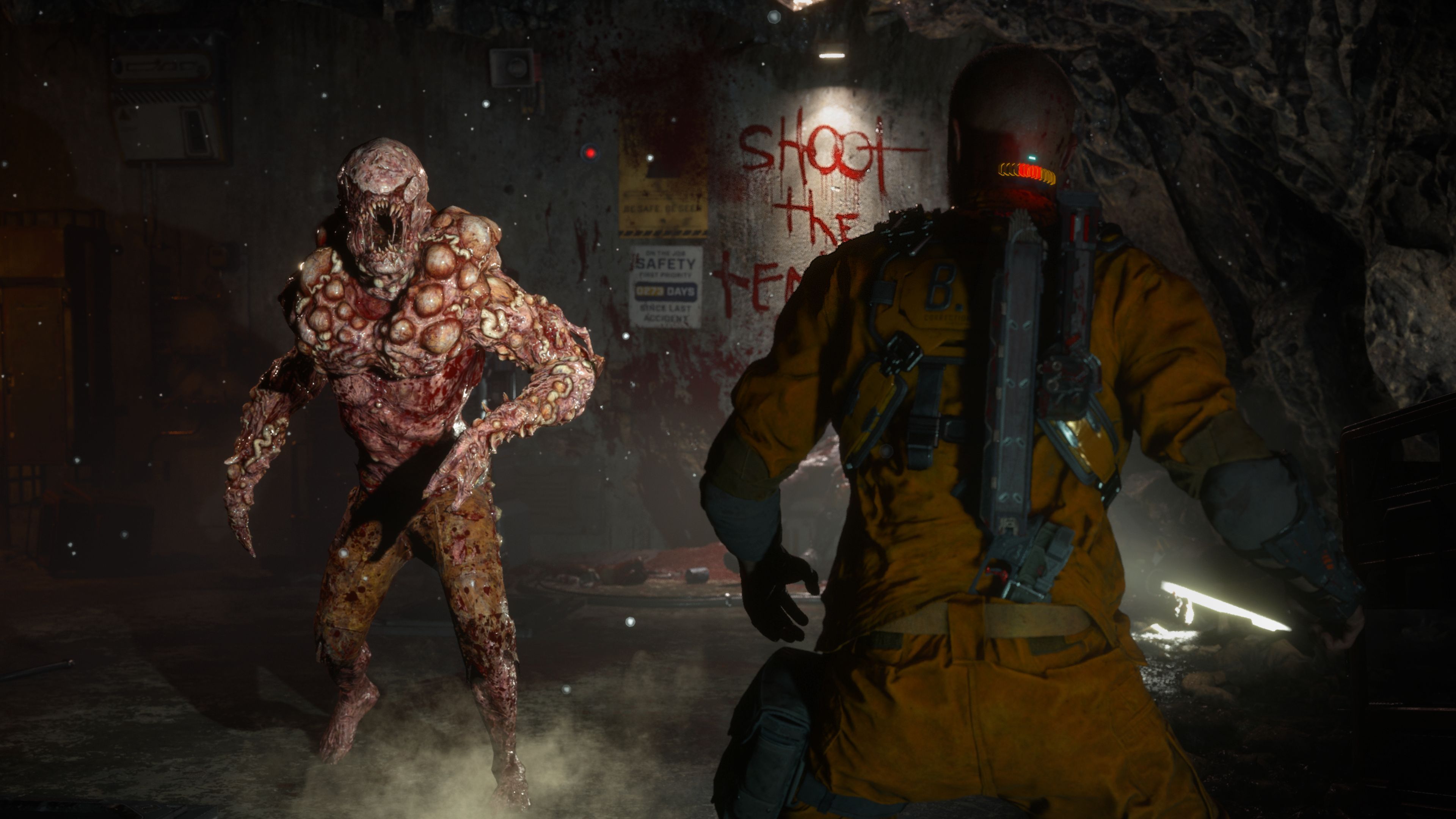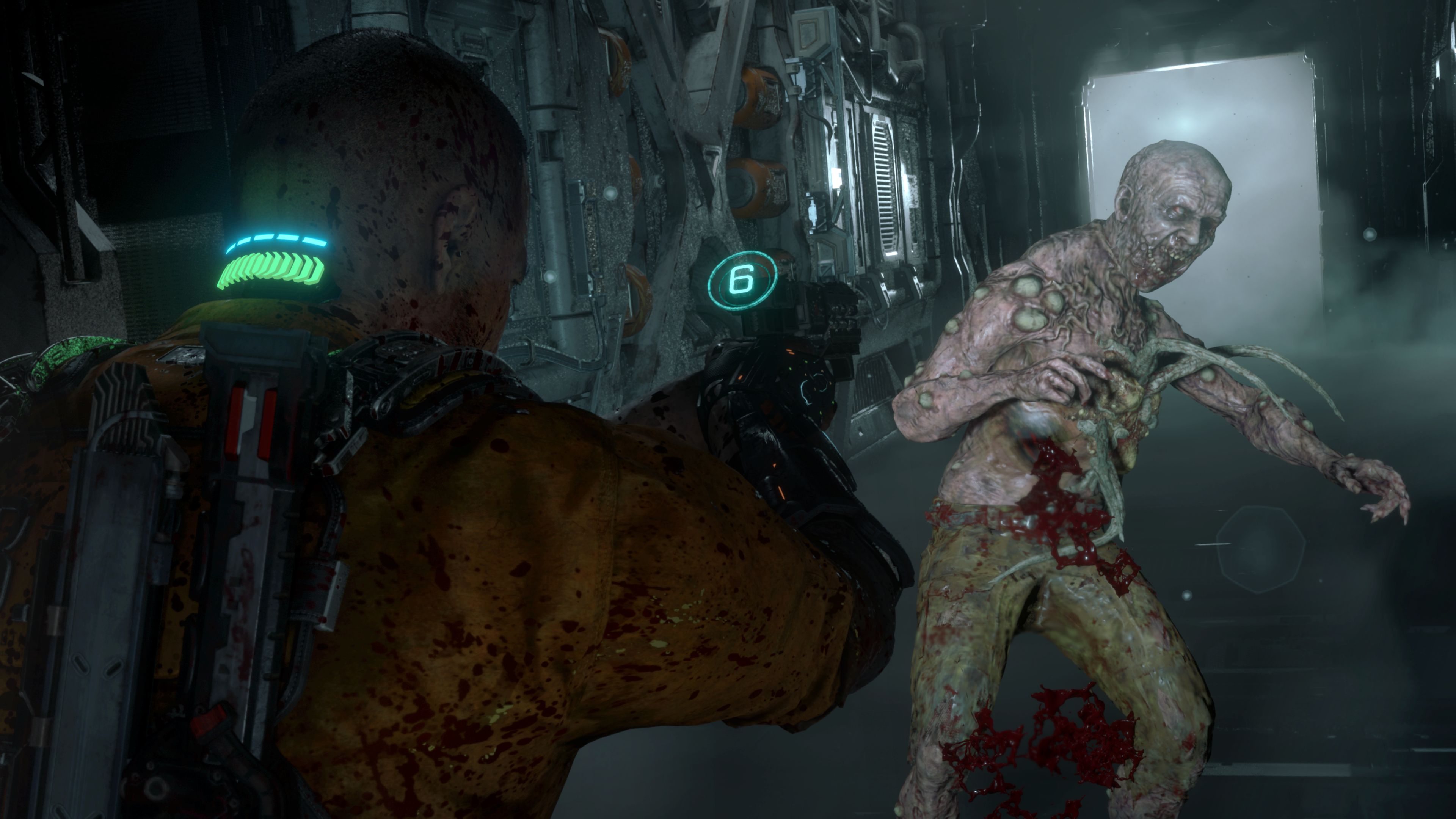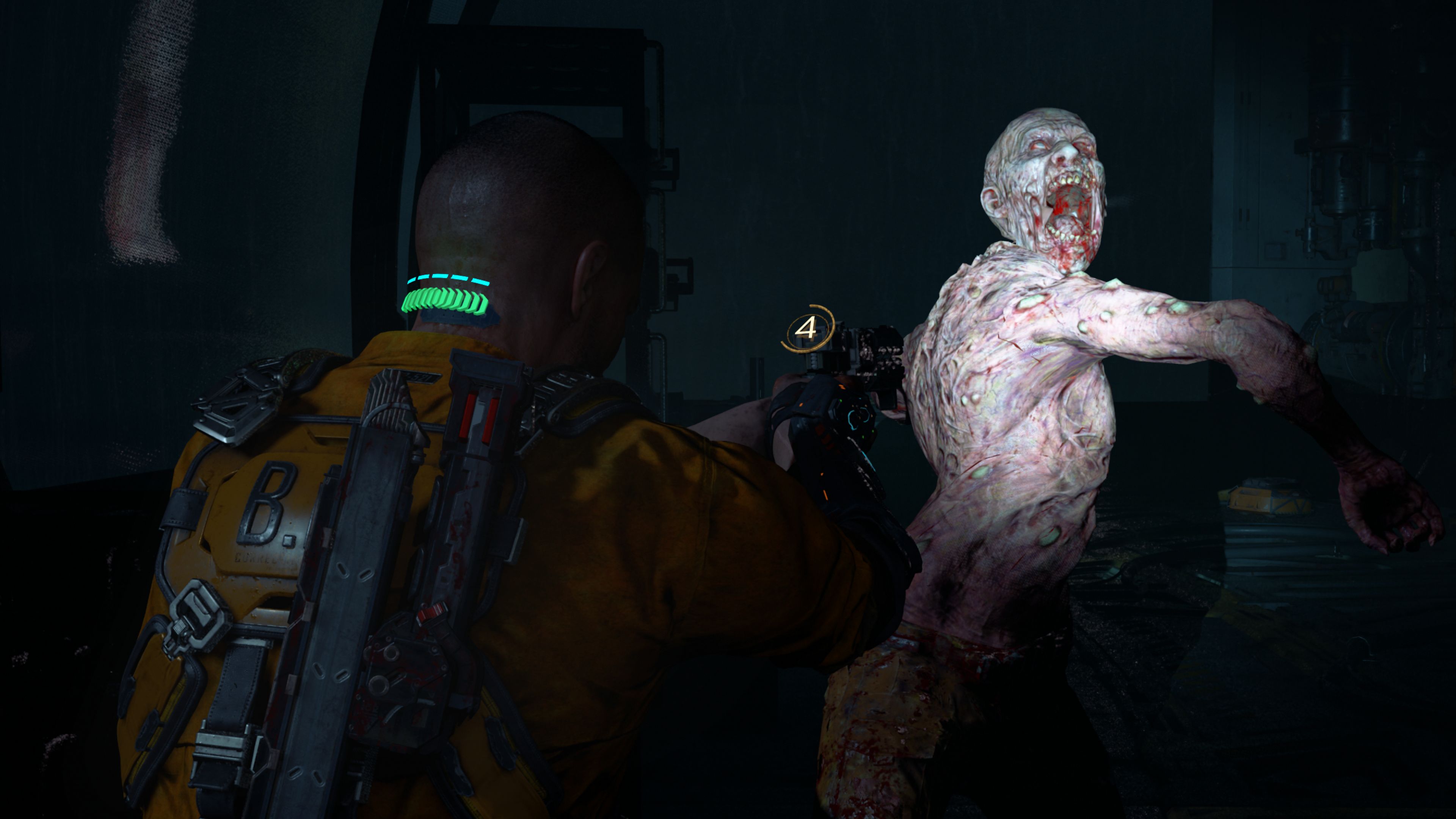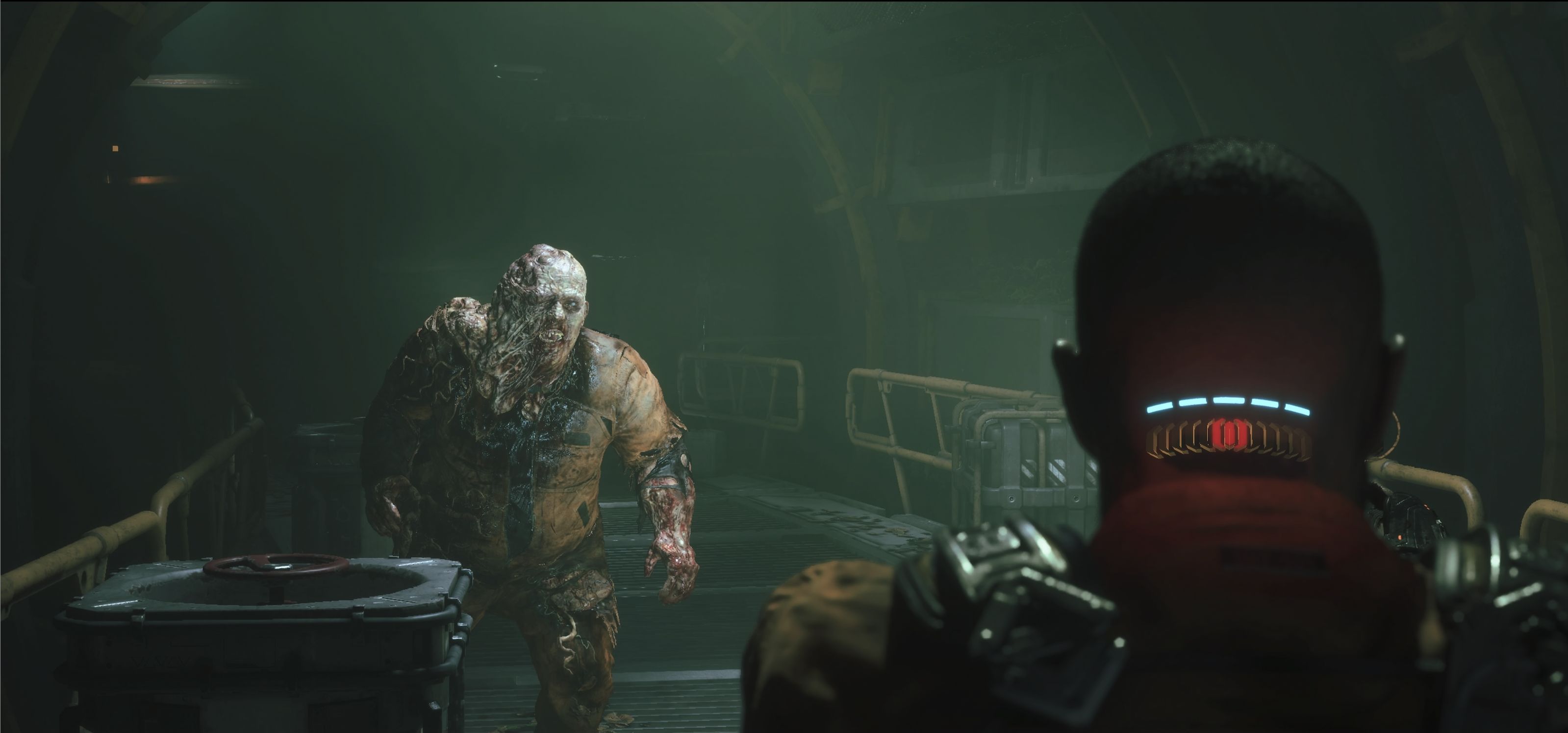
GameCentral gets to play the new game from the co-creator of Dead Space and discovers what may be the goriest video game ever.
It’s Halloween in a few days and suddenly, unexpectedly, things couldn’t be looking better for video game horror. Admittedly, there are no big name titles out this month but on the horizon are for 4, , and . There will be new games as well though, with the most prominent new IP being The Callisto Protocol – a new sci-fi horror by the co-creator of the original Dead Space.
Glen Schofield only worked on the first game, before leaving EA to set-up Sledgehammer Games and work on Call Of Duty titles including Modern Warfare 3, Advanced Warfare, and WW2. Now he’s back with a new developer called Striking Distance Studios and what is clearly intended to be a spiritual sequel to Dead Space.
We spoke to Schofield at length about the current state of modern horror, and The Callisto Protocol, but we also got an hour and half on the game itself. The demo started from around the three hour mark, so we missed all the story set-up, but our understanding is that it involves some sort of alien infestation at a prison on Jupiter’s moon Callisto, that appears to have been enabled by the prison warden.
Story or not, the first thing that strikes you about the game is just how good the graphics are. The camera sits very close to the game’s protagonist (who unfortunately comes across like a stock bald space marine from the Xbox 360 era) but from a technical perspective the game is very impressive. More so than the Dead Space remake, from what we saw, with some very detailed locations and disgusting looking enemies, with everything having a very convincing sense of weight and physicality.
The gore effects, which Schofield is clearly very proud of, are especially good/disgusting, with people’s heads getting bitten in two and so many over-the-top death scenes it almost seems like something out of Mortal Kombat. The creature designs, that we’ve seen so far, don’t seem terribly original though, as they all appear to be mutated humans, with The Thing clearly being a major influence on the designs.
You’d have to say that the gameplay also isn’t doing anything particularly original. It’s all extremely well-orchestrated but at the end of the day you’re still just stomping around fighting monsters and working out how to open an awful lot of locked doors.

The combat is very good, better than usual for a horror game, with a very useful dodge move and a gravity gun style gadget that allows you to pick up and throw explosive barrels or use monsters as human(-ish) shields. All of it works well but none of it is very surprising, including the big new idea of having to shoot the tentacles off a monster before they evolve into something more dangerous.
This is so obviously inspired by the dismemberment tactics of Dead Space it almost feels a little desperate, and while the panic to shoot the tentacles, with your limited ammo, is exciting it doesn’t seem enough to base a whole game around.
There is also the expected upgrade options for all your weapons, which are a lot more involved than Dead Space, as well as quite a lot of QTE sequences. Plus, a Tomb Raider style log flume sequence where you’re being carried along a water pipe and have to avoid giant fans that will literally cut you in half if you get caught.
The Callistol Protocol is exactly as goopy and disgusting as it’s obviously meant to be, but we do hope there are some gameplay twists we haven’t yet seen or otherwise this is going to feel like a bit of a missed opportunity. It’s clearly a much better game than Dead Space 3 but beyond that it still has a lot to prove.
Formats: Xbox One, PlayStation 4, Xbox Series X/S, PlayStation 5, and PC
Price: £54.99
Publisher: Krafton
Developer: Striking Distance Studios
Release Date: 2nd December 2022
Age Rating: 18
GC: I don’t know about anyone else but my last three press events have now been for the Dead Space remake, the Resident Evil 4 remake, and now this.
GS: Really?
GC: So in terms of third person, over-the-shoulder survival horror I feel sated.
GS: [laughs] It’s amazing how that kinda thing happens.
GC: Although really, Resident Evil 4 does feel very different to this.
GS: Yeah, Resident Evil… I’m looking forward to that myself.
GC: I was really worried they’d take out the cheese but it’s still got some of the original lines in there.
GS: Really? That’s great.
GC: But so, that’s a good example of how horror games can be very different, even if there are surface similarities. Resident Evil can be goofy, Silent Hill is more psychological, I think gross is the first word that comes to mind with The Callisto Protocol? Are you happy with that description?
GS: [laughs] Brutal. Brutal is the word I would choose.
GC: It’s disgusting in the best possible way. And when you were talking in the intro about everything being very close to the camera it feels…
GS: Very in your face!
GC: Yeah. So how did you decide how to go about this, because it’s been a long time since Dead Space and you’ve been making Call Of Duty in the interim. What kind of action games were you looking at to inspire this, because it almost feels Gears Of War-esque.
GS: The truth is that’s my style now. It’s evolved since Dead Space 1, since watching a lot of movies and playing games. Now there aren’t lot of games that are up close and personal, engrossed and stuff like that. But definitely American horror has gone that way.
It’s definitely coming into… well, there’s even some old stuff in Europe, especially in France. And I see it starting to get into the Korean films, where bones are cracking and it’s just more about humans and they’re not afraid to freak you out or… and that’s the way I am. It’s just like: let’s do this!
GC: It’s a sort of more realistic version of body horror, which tends to be quite fantastical. Whereas these injuries look like something you’d get in a car crash or something.
GS: Yeah, yeah. So for Dead Space, when we did dismemberment, you only had two or three dismemberment points back then. And so when we were making this game – the Dead Space remake hadn’t been announced and I didn’t know about it, I don’t know a heck of a lot about it now.
So I said, if I hit ’em in their wrist, I want the hand to fall off, and so on. If I smack him in the head, his head doesn’t fall off but maybe half does. I wanted it just to be realistic. Realistic gore.
GC: I always wanted that in a sword-fighting game. It seems silly when all you get is a little blue flash.
GS: There you go! Yeah, yeah. That was a technical limitation that the new platforms don’t have.

GC: I always like to guess what question you’ve been asked the most today already, and I’m guessing it’s whether this is what you wanted Dead Space 4 to be?
GS: Um… no I haven’t gotten that question.
GC: Oh, someone’s slacking. I thought you’d be sick of that by now.
GS: [laughs] I’ve never thought about Dead Space 4, because I had left for Sledgehammer Games and to work on Call Of Duty and…
GC: You weren’t thinking, as the series progressed, what you would have done with it? Is this not that game?
GS: This is definitely that game. This is not Dead Space 4 though, this is like… I want a standalone, because I would like this to go on, but this is where I see horror and video games going.
GC: The Dead Space remake wasn’t bad, I liked that they added some new features to it, but just from things like the room size you could tell it was an old design, meant for Xbox 360 era consoles. I’m curious as to how you made the big choices for this, though? Because it’s not hard to imagine this could have been open world or something with a different structure or setting.
GS: Yeah, I mean I’ve already got ideas for another one if we decide to go that way. So, I’m not gonna go there. But this was all about combat, right? This is one that I’m like, ‘Okay, we gotta get the room sizes right.’ So that was a good deduction there, ’cause one of the first things we do is we get the metrics.
Here’s how a door needs to be, how tall the ceiling needs to be… and then you can mess with it from time to time. But we get the metrics right and then I wanted it to be really immersive. So we spend time on the eyes ’cause as an artist, when I look at some character’s eyes, they take me out of the game. Or the teeth.
So I was like, ‘Okay, let’s get our main character right and let’s get the other characters right. So it doesn’t take me out of game.’ Another thing we did was… animation will take me out of the game. So we built a mocap stage, so we could get whatever animation we want. So there was like, ‘Okay, let’s get that out of the way.’
And then how are we gonna immerse the player? Because I want them feeling like they are right there. The more you’re up close and personal, the more you’re gonna get scared, in my opinion.
GC: I like when he was wiping the sweat from his brow, after a fight. And actually I remember The Evil Within being really bad with faces. You would pan the camera around and the main character has just got this totally blank expression on his face.
GS: That bothers me too. And that’s why Jacob’s covered in blood and he gets sweatier. We have facial animation for the furrows in his brow and stuff like that.
GC: You say the combat is a focus, and it is good, but is there a danger it could be too good? In the sense that you begin to enjoy it for its own sake, and you’re no longer being scared. I’m a big fan of games like Bayonetta and Devil May Cry…
GS: Right, me too.
GC: And I really like the dodge in this game, but then I’m thinking, how far are you going to push this? Are there going to be some set pieces that are just a room full of monsters to fight? You did start to get that with the room with the three invisible ones in it.
GS: There are a couple places where there may be more enemies, but it’s not usually that simple. They may duck into another door and they may come back or they may go through the… I don’t know if you recognise the vent system we have? And so it will get a little more complex but we make it also scary and intense ’cause you’re like, ‘Where did that guy go?’
GC: At first I imagined your studio as an indie team but you’re owned by…
GS: Krafton.
GC: But the graphics are fantastic.
GS: Thank you.
GC: So are you a triple-A studio? I feel the importance of that distinction is lessening every day.
GS: Well, I got about 35 people from this place, that have all worked with me through Call Of Duty, a lot of us have just continued to up the ante, then we go to the colleges and we try and get the best and the brightest. So we’ve got young blood coming in and a lot of ’em when they heard, ‘Hey, these are the Dead Space guys going to make another horror game’, they were like, ‘Sign me up!’ In the beginning it felt like a start-up, right?
GC: Yeah, yeah. That’s what I was getting at.
GS: But as far as… I think even Krafton didn’t realise what they had.
GC: How many people are at the studio?
GS: About 200 now. But a lot of ’em work at home now.
GC: I really don’t know what to expect from games nowadays, where an indie game genuinely can look better than a triple-A sometimes.
GS: Yeah, yeah. It really depends… you need a studio that knows how to make the most out of its [resources]. My first degree is in art. So we know how to go get artists, go get the best and to hire an artist for 30 years. And so being around that long, we just all have contacts. We know who the best audio guys are and you know and just try to win them over with the project.

GC: There’s a lot of talk at the moment of us being in another survival horror renaissance, but they’ve said that before and it never stuck. Do you think it will this time? What has been the problem previously, do you think?
GS: I think sometimes that they get labelled with survival horror, in the video game industry, when they’re not; they’re just horror. Whereas in the movies they just say, ‘This is a horror movie.’ So I think a lot of times people are like, ‘That’s not a survival horror game!’ But it gets lumped in there with them. So there are some to me that are scary. It’s a haunted house and that that’s the way I play it. But survival horror is a different animal.
My style of survival horror is… I still have a weapon in my hand. I don’t want to feel helpless, but I got a weapon. I don’t like the games where I gotta run around just looking for one bullet all the time. I think it’s like, ‘Okay, just give me five, you know?’ And so this is survival horror, but this is another brand of it. This is maybe the next step.
Will it stick around? It depends, of course, on how good all the games are. The fans are… they’re the ones who will talk. They expect quality, they’re spending a lot of money. So it’s up to us.
[We’re told to wrap up the interview by the PR people.]
GC: How important is it that this is a sci-fi game? Is that just a detail?
GS: Not to me, not to me. I was first and foremost a sci-fi guy. So when I was in school and I’m painting, I’m think of sci-fi. So I am so passionate about it. It’s not a detail if you get it right. Some people just throw sci-fi together and they don’t think about it. And that’s not sci-fi to me. You gotta be as passionate about sci-fi as you are about the horror. And I love the challenge of taking something that’s 300 years in the future and making it believable.
GC: I just wish people would stick to the science more closely, because that would, ironically, make things more fantastical. Like, in the Dead Space remake they’ve got these new zero-G sections but when you shoot a gun there’s no recoil – that’s completely missing the whole point and the chance for some really interesting mechanics.
GS: Yeah, yeah. You need to think about some of the details.
GC: In our solar system we have planets with methane seas and clouds of sulphuric acid, and yet all we get in movies and games are desert and forest planets.
GS: Yeah, Yeah. Definitely. That’s why our game is set on Callisto, because scientists say that that could be one of the places that could harbour life, because it has liquid water – a hundred miles under the ice it’s all water. So that’s why it’s there. And there’s a lot of stuff like… when I made Advanced Warfare the rule was it either has to be a hypothesis, a theory or a prototype.
GC: I remember you saying that in a press event.
GS: It’s important to mean that kinda stuff, you know?
GC: If you accept that truth is stranger than fiction then just read some non-fiction and you’ll get some crazy ideas.
GS: Yep, yep. 100%.
GC: Okay, well I gotta stop, but do you have zero-G in your game? I think the developer earlier was suggesting I was going to get thrown out an airlock if I got any further?
GS: You’re going to get thrown out onto the planet. That is a real pallet cleanser that one.
[Looking around, the PR person telling us to hurry up seems to have disappeared.]
GS: You can ask another question!
GC: OK, don’t get offended by this but my pet peeve, and no one ever agrees with me on this, is I hate audio logs. I just hate them, they’re so unrealistic and overused. The only reason they exist is because 20 years ago you couldn’t have a realistic looking human talking to you. I strongly feel they should’ve stopped then.
GS: [laugh] Oh, really?
GC: It’s a really old mechanic that everyone, including you, keeps and yet there’s so much evolution in other areas.
GS: To me it’s still about your… I see everybody, including journalists, just taking their phone and going, ‘blah, blah, blah’ [mimes talking into a phone] but they’re putting stuff into it. So I’m like, ‘In the future, is that going to go away?’ And I don’t think so. Am I gonna stop and make a visual log of myself? Selfies are hard enough!
GC: There’s audio logs at one end of the scale and at the other there’s the Red Dead Redemption thing of having a 20-minute horse ride with someone that just will not stop talking. I can’t help but feel there must be some happier medium between those two extremes.
GS: Yeah, yeah. I get you. That’s funny, I hadn’t thought about it from your perspective, but it’s a way for us to keep you isolated and tell you more about the story. And it really is important that you get some of these details. But that’s an interesting take.
GC: OK, I really better make this the last one. Oh, but just first: did you ever consider adding co-op to the game?
GS: No, no. There’s no co-op because I just think it’s not scary.
GC: I figured you’d say that. But the thing I don’t know the answer to is how you decide how gross to make the game. That must be a very strange thing to judge. Is that you personally looking at something and thinking that it’s okay or a bit too much?
GS: No, I don’t, have a filter there. That’s what’s unfortunate. [laughs] And, you know, there’ll be a few places that we probably won’t be able to get into and that’s just… Krafton has said, ‘Glen, go make your game.’ They never said, ‘But you can’t do this, you can’t do that.’ They just said make your game.
GC: When the monster bites your head off, and you can see all the gore, it really is disgusting. But in a very impressive way.
GS: That’s the way I look at it! I’m like, ‘I haven’t seen that in a game before!’
GC: And in most modern movies too. Don’t get me started on CGI blood.
GS: I know, I know. [laughs] We do try though; I mean we try to make something you haven’t seen before. But those were some great questions. You got into my mind.
GC: Well thank you, thanks for your time.
Email [email protected], leave a comment below, and .
Follow Metro Gaming on and email us at [email protected]
To submit Inbox letters and Reader’s Features more easily, without the need to send an email, just use our .
For more stories like this, .




















